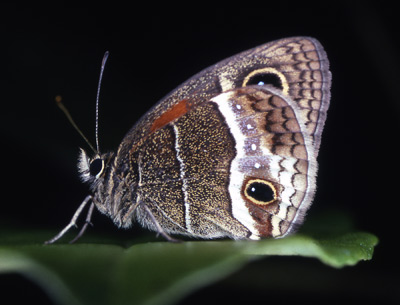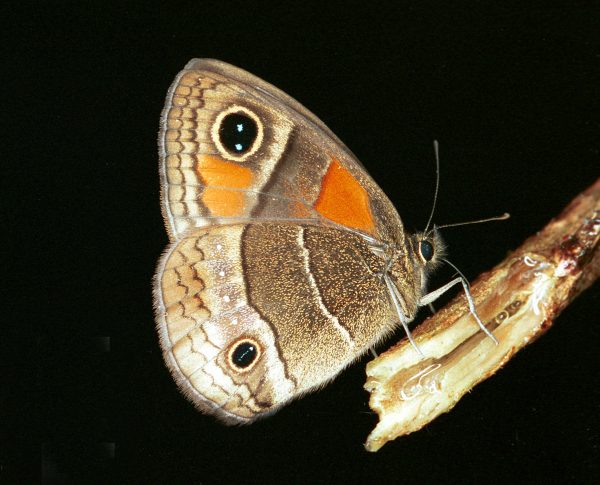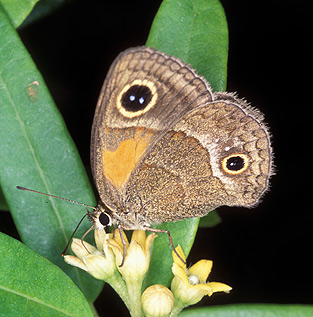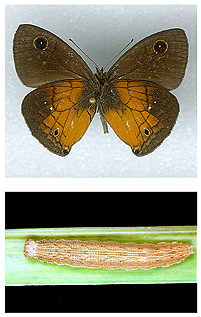When Charles Darwin journeyed to the Galapagos Islands in the 1830s, he collected some mysterious birds that later helped shape his theory of evolution by natural selection. Dubbed “Darwin’s finches,” they became famous as an example of adaptive radiation, in which animals evolve from a common ancestor to utilize different ecological niches.

Photo by Andrei Sourakov
Two centuries later, on the Caribbean island of Hispaniola, a Florida Museum of Natural History researcher was attracted to a group of insects he calls “Darwin’s butterflies” because of their similarly high degree of diversity derived from a common ancestor. But it wasn’t until 20 years after beginning his research on the genus Calisto as a University of Florida Ph.D. student that Andrei Sourakov found the missing link for understanding how the group should be classified.
“DNA barcoding was the perfect tool to look at this genus because a lot of these species were separated based on only wing patterns, and it’s difficult to prove whether these differences correspond to species, or just represent variation,” said Sourakov, Florida Museum Lepidoptera collection coordinator. “DNA actually allows us to evaluate if and when the gene exchange occurred.”
In a study published Aug. 24, 2011, in Comparative Cytogenetics, Sourakov revised the genus Calisto to include 34 species and 17 subspecies, nine fewer species than previously established, providing better organization for the 54 known taxa. His results are based on his knowledge of morphology, ecology and genetics of these butterflies, and they accompany a strong warning not to abandon other methods of taxonomic classification.

Photo by Andrei Sourakov
“In general, a lot of people look at DNA sequencing as a substitute for taxonomy and it really doesn’t work this way,” Sourakov said. “One should really know the group they work on to understand what they are looking at – there might be errors in sequencing or in specimen identification, genetic introgressions and other unforeseen circumstances, and if a person isn’t familiar with the group, it can result in extremely erroneous conclusions. DNA is another dataset, like larval or adult morphology, not a substitute.”
The genus Calisto boasts the greatest diversity of butterflies native to the Caribbean, from individuals living in the lowland deserts to their immediate relatives in the mountains. The second-largest Caribbean Island, Hispaniola, formed when two land masses collided more than 50 million years ago, then separated from the archipelago about 25 million years ago. Previous theories suggested these geological occurrences explained the high diversity within the genus and its presence on Cuba, Jamaica, Puerto Rico and the Bahamas, but calculations from the study establish a younger evolutionary history than researchers previously expected.

Photo by Andrei Sourakov
“This study falsifies the hypothesis that ancient geological events of continental movement were main factors of diversification in this group,” said Vladimir Lukhtanov, leading research scientist at the Zoological Institute in St. Petersburg and professor at St. Petersburg State University in Russia. “Rather, Darwinian adaptive evolution triggered the rapid species formation in Calisto. I think this work is a great step to understanding the phenomenon of accelerated species evolution on oceanic islands.”
Hispaniola is humid and tropical, but its unique geography includes flooded grasslands, pine forests, savannas and five major mountain ranges. Before researching the island’s fauna, Sourakov studied the host plants of the butterflies to better understand their correlation with the evolution of the genus and how different niches were occupied.
While the different Calisto species look similar – small and brown with eyespots on the undersurface – the caterpillars develop to feed on diverse plants, from bamboos and canes to desert bunch grasses and their roots.
“Some of them have names like confusa, enigma, obscura for a reason – it’s because people have a very hard time identifying them,” Sourakov said. “They are described as a single genus based mostly on distribution, and studying their molecules can allow us to see the deeper differences in these butterflies.”

Photo by Andrei Sourakov
One species, Calisto pulchella, has had economic importance as a wide-ranging pest of sugarcane, and the DNA barcoding showed greater diversification than expected, supporting a previous separation into an additional species, Calisto darlingtoni.
“I knew that this butterfly fed on sugarcane, but I searched and searched and could never find the caterpillar,” Sourakov said. “Then finally it occurred to me to pull off the leaf, and there it was – feeding practically inside the stem! These butterflies are really adapted to their specific host plants, something I’d never have guessed by simply studying dead specimens in the collections.”
On Hispaniola, there are about 200 species of butterflies in more than 100 genera, and Calisto represents over 20 percent of the total, a phenomenon that is “quite remarkable,” Sourakov said.
“Names only exist in the minds of people, but in order to talk to each other, we have to have names and these names have to have meaning, and taxonomic revisions allow for that,” Sourakov said. “But, this paper is a little more to me than just a revision because it has so many implications for the evolutionary history of Calisto, and for understanding butterfly evolution in general, especially on tropical islands.”
The study was co-authored by Evgeny Zakharov of the Biodiversity Institute of Ontario at the University of Guelph.
Learn more about the McGuire Center for Lepidoptera & Biodiversity at the Florida Museum.